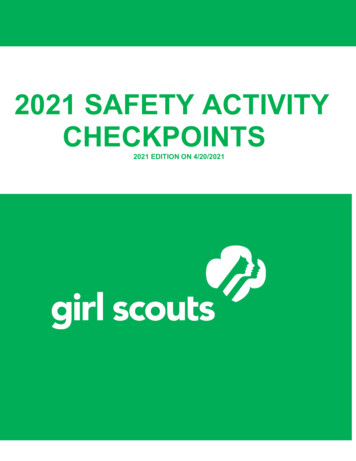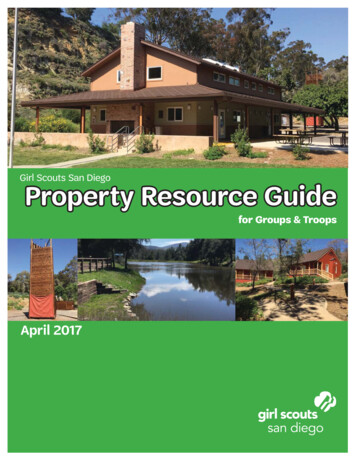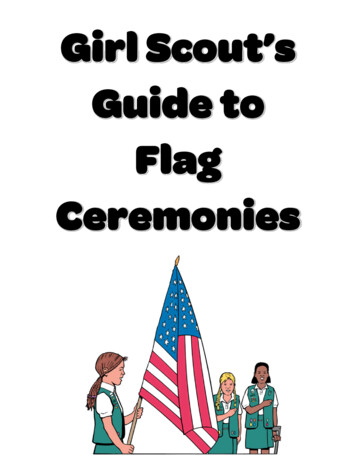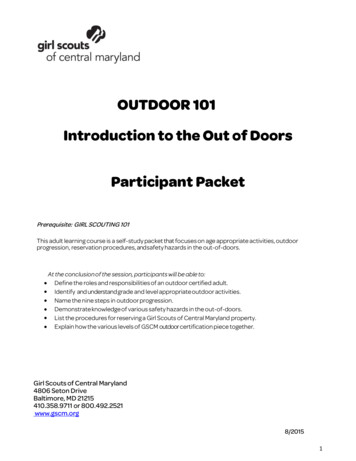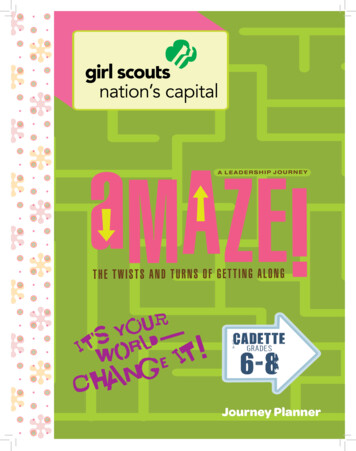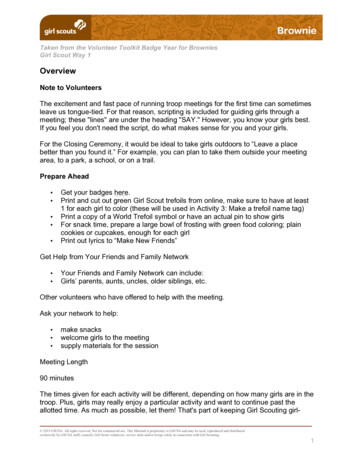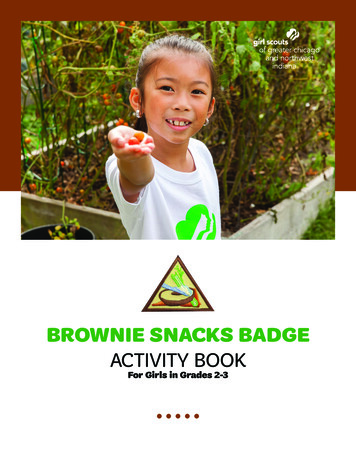
Transcription
-SAFETY ACTIVITYCHECKPOINTS2021 EDITION @ APRIL 1, 20211
Table of ContentsIntroduction . 4Standard Safety Guidelines . 4Coronavirus Safety in Girl Scouts. 7Have an Emergency Action Plan (EAP) . 8Understanding Which Activities Are Not Permitted . 12Chartered Aircraft Trips and Aviation . 14Other Actions Girls and Volunteers Should Not Take . 14First Aid . 14Overall Health, Well Being and Inclusivity . 17Transporting Girls . 19Troop Meeting Space . 21Activities at a Glance . 23Aerial Fitness . 38Amusement Parks. 41Animal Interaction . 43Backpacking . 47Bicycling . 50Camping . 54Climbing and Adventure Sports—Master Progression Chart . 60Challenge Courses . 61Climbing and Rappelling . 64Recreational Tree Climbing . 67Zip Lining. 69Community Clean Ups . 72Computer and Internet Use . 77Computer Internet Safety Pledge . 80Virtual Troop Meetings . 81Cookie and Product Sales . 85Cross Country Skiing . 88Downhill Skiing and Snowboarding . 90Fencing . 93Fishing and Ice Fishing . 95Ice Safety Quiz. 99Geocaching . 100Go-Karting . 1032
Hayrides . 105Hiking . 107Horseback Riding. 109Ice Skating and Roller Skating . 113Indoor Skydiving . 117Indoor Trampoline . 119Inflatables . 121Miscellaneous Activities . 124Offshore Water Vessels . 125Orienteering . 130Outdoor Cooking . 132Parades and Other Large Gatherings . 138Paddling and Rowing Sports—Master Progression Chart . 141Canoeing . 143Corcl Boats. 147Kayaking . 149Row Boating . 153Standup Paddle Boarding . 157Whitewater Rafting. 161Pocket Knife and Jackknife Safety . 165Pocket Knife/Jackknife Safety Pledge . 166Rocketry / Model Rocketry. 167Sailing. 172Scuba . 176Sledding and Tobogganing . 181Snorkeling . 183Snowshoeing. 186Spelunking/Caving . 188Surfing . 191Swimming. 194Swimming Test – Documented Verification of Completion . 198Target Sports . 200Archery . 203Ax, Knife, and Hatchet Throwing . 206Slingshot . 210Tools – Hand and Power . 213Tethered Hot Air Balloon Rides . 2173
Travel / Trips . 220Tubing . 228Waterskiing and Wakeboarding. 230Windsurfing . 234IntroductionSafety Activity Checkpoints (SACP) is a resource that provides the standard safety guidelines for Girl Scouts ofthe United States of America (GSUSA) approved activities.GSUSA, local councils, and other units holding a credential – including USA Girl Scouts Overseas (USAGSO)– shall be responsible for seeing that all activities are planned and carried out in a manner that considers thehealth, safety, and general well-being of all participants in accordance with these standard guidelines.Throughout Safety Activity Checkpoints, several individual activities, such as Paddling and Rowing, Climbingand Adventure, and Target Sports, are categorized under related sections to provide continuity as well as thegrade level and skill progression.Standard Safety GuidelinesThis section provides GSUSA’s standard safety guidelines, by topic, that apply to all Girl Scout activities.Please read and become familiar with all topics in this section. These standard safety guidelines are to be usedtogether with the specific safety checkpoints for an individual activity along with reasonable common-senseadjustments to ensure a safe positive experience for girls. The intent of providing these standard safetyguidelines is to establish a checklist for success and to foster confident leadership.Note that throughout Safety Activity Checkpoints, several individual activities, such as Paddling and Rowing,Climbing and Adventure, and Target Sports, are categorized under related sections to provide continuity aswell as the grade level and skill progression.Adult Supervision. The adult supervision rule at Girl Scouts is a strict standard that requires whenever girlsmeet, whether in person or virtually, there must be at least two registered, approved adult volunteers who areunrelated (for example: not a sibling, spouse, domestic partner, parent, child, or anyone who would beconsidered a family member) and who do not live in the same residence with a minimum of one who is female.This applies to every Girl Scout gathering including troop meetings (in person and virtual), day trips, camp,sleep away travel, events, activities, and projects. There are no exceptions to this rule.There are different specific adult-to-girl ratios requirements for Girl Scout troop meetings as compared toevents outside of the regular Girl Scout troop meeting such as outings, activities, camping and travel. Activitiesand travel outside of the regular troop meeting space require more adult supervision.For Troop MeetingsThe adult-to-girl ratio means a minimum of two registered, approved, adult volunteers who are unrelated,including one female, for up to this number of girls: 12 Girl Scout Daisies20 Girl Scout Brownies25 Girl Scout Juniors4
25 Girl Scout Cadettes30 Girl Scout Seniors30 Girl Scout AmbassadorsThere should be one extra registered, approved, adult volunteer for every additional: 1–6 Girl Scout Daisies1–8 Girl Scout Brownies1–10 Girl Scout Juniors1–12 Girl Scout Cadettes1–15 Girl Scout Seniors1–15 Girl Scout AmbassadorsFor Outings, Activities, Travel and CampingThe adult-to-girl ratio means a minimum of two registered, approved, adult volunteers who are unrelated,including one female, for up to this number of girls: 6 Girl Scout Daisies12 Girl Scout Brownies16 Girl Scout Juniors20 Girl Scout Cadettes24 Girl Scout Seniors24 Girl Scout AmbassadorsThere should be one extra registered, approved, adult volunteer for every additional: 1–4 Girl Scout Daisies1–6 Girl Scout Brownies1–8 Girl Scout Juniors1–10 Girl Scout Cadettes1–12 Girl Scout Seniors1–12 Girl Scout AmbassadorsSome high-adventure activities may require more adult-to-girl supervision than stated above. For thoseactivities, the safety checkpoints will provide specific adult-to-girl supervision ratios. Remember, some activitiesare less safe for younger girls, particularly Daisies and Brownies. Younger girls may not be permitted toparticipate based on their age, as appropriate, and this will be specified on the individual activity. In caseswhere younger-girl participation is an option but only under certain conditions, this is indicated toward the topof the activity chapter (typically with an asterisk followed by an explanation further into the write-up).Note: For mixed-grade level troops, use the ratio for the lowest grade level in the troop. For example, if thetroop consists of Daisies and Brownies, the Daisy ratio should be followed.Council Approval Requirement. At the top of each activity page, you will see a field indicating whether yourcouncil’s prior approval is required to perform the activity. Council prior approval is required for those activitiesthat are rated as high risk by Girl Scouts’ national insurance carriers. A council may approve an activity one5
time for the duration of the year or require more frequent approvals each time the activity takes place. This is acouncil decision as local norms and laws vary from state to state. Required. You must check in with your council for prior approval before taking girls.Not Required. You do not need to check in with your council for prior approval.May Be Required. Your council will determine if prior approval is required.Activities Not Listed in Safety Activity Checkpoints. In a challenging, learn-by-doing environment like GirlScouts, it is only natural that girls will sometimes want to take part in activities that are not specificallyaddressed in Safety Activity Checkpoints. If a specific activity is not provided in Safety Activity Checkpoints thefirst step is always to contact your council to make sure your council approves of the activity.Remember to have a plan or process in place for addressing and handling requests for activities that that arenot specifically listed in Safety Activity Checkpoints: Consult your council for clarification and approval before taking girls. Your council may or may notpermit the activity. If your council does approve the activity, they may direct you to a specific vendor orfacility or advise you to stay away from others.Investigate whether the activity is similar to another activity and if the safety checkpoints can easilytranslate and apply to a covered activity, then follow those checkpoints.Consider whether the proposed activity requires any additional expert supervision or specialcertification for the instructor.As with approved activities, think about the quality of the experience in terms of how participation tiesback to long-term outcomes girls receive in Girl Scouting.Selecting an Activity to do with Girls.When considering what type of activities to do with girls, whether specifically listed in Safety ActivityCheckpoints or not, be thoughtful and intentional with selecting the activity. Be mindful about the long-termpositive outcomes that girls receive through Girl Scouting and think about how participating in the activity tiesinto at least one of these outcomes. Girl Scouts has proven to help girls thrive in 5 ways:Strong Sense of SelfGirls have confidence in themselves and their abilities and form positive identities.Positive ValuesGirls act ethically, honestly, and responsibly and show concern for others.Challenge SeekingGirls take appropriate risks, try things even though they might fail and learn from their mistakes.Healthy RelationshipsGirls develop and maintain healthy relationships by communicating their feelings directly and resolving conflictconstructively.Community Problem SolvingGirls contribute to the world in purposeful and meaningful ways, learn how to identify problems in thecommunity, and create “action plans” to solve them.Activities chosen should work towards intentionally helping girls be successful in these key areas. As part ofthe planning process, consider how and why the activity selected connects to the Girl Scout outcomes. Make itgirl led by sharing these goals with girls and engaging them in the activity selection process.6
Coronavirus Safety in Girl ScoutsThe health and safety of girls are always the highest priority in Girl Scouts. Returning to in-person activities,especially after a long time of shelter in place for most communities, is a long-awaited development thateveryone in Girl Scouts will need to continue to manage carefully. Recognize that COVID-19 health and safetyguidance will continue to adjust as the coronavirus transmission risk changes over time.Girl Scouts has provided COVID-19 guidance specific to the topics that touch our lives in Girl Scouts such astroop meetings, activities, and day trips. Your council’s COVID-19 guidance is the first place to go for healthand safety practices in Girl Scouting. You can access that guidance here: [Council Inserts their customizedCOVID-19 Guidance here]Remember, always make sure that your planned activity is also in compliance with the federal and stategovernmental health authorities where the activity will take place. This means the Center for Disease Control(CDC) and your State Department of Health (DOH) as well as local or county health directives. For example, ifyour county or region has a governmental directive that requires no large in-person gatherings, then that rulemust be complied with. Girl Scouts are always obligated to comply with our governmental health authorities.On the other hand, for a variety of reasons, there may be situations where your council’s guidance is more strictthan state or local guidance. If that is the case, either choose the rules that are most strict or contact yourcouncil for clarification.Recognize that state and local rules concerning coronavirus safety can vary from place to place. Safetyregulations will also change as the transmission risk changes. Be sure to stay current on what is required inyour region but also consider that girls in your troop may reside in a different area with a different set of safetyparameters to abide by. A good way to ensure you are following the proper governmental guidance is to followthe practices as established in local public schools.Some basic safety standards that have been issued by the Center of Disease Control (CDC) for integratingback into in person gatherings are:-Wear a mask (and make sure that girls wear a mask).Practice good hygiene by washing or disinfecting hands frequently.Remind girls and adults about social distancing when in public and with each other.Focus on scheduling activities outdoors instead of indoors whenever possible.Pre-screen for no symptoms, fever or sustained contact with a COVID-19 positive personRequest that a girl or adult who is exhibiting symptoms of being sick not participate and return whenshe is no longer sick.Remember: If a girl or adult knows that they have been in close and sustained contact withsomeone who has tested positive for coronavirus, make sure that they comply with the appropriatequarantine period pursuant to the CDC before attending Girl Scout meetings or activities.The CDC provides regular updates on their website which can be accessed here:Coronavirus Disease 2019 (COVID-19) CDCSome excellent guidance for mask wearing and the effectiveness of double masking can be accessed here:Use Masks to Help Slow Spread CDCImprove How Your Mask Protects You CDC7
Have an Emergency Action Plan (EAP)The Girl Scout motto is "Be prepared.", and proper preparation is the key to success. An important thing toconsider ahead of time, before taking girls out on a trip or to an activity, is an Emergency Action Plan.Volunteers can review their troop’s Emergency Action Plan with girls as a learning experience for them, to theextent it makes sense according to their age and maturity.For the adult volunteer, however, it is important to think about and document an emergency action plan in theevent of an emergency or injury. Think through scenario of what can go wrong such as physical injury to a girl,severe weather, fire, intruder, missing girl or sudden illness. This simple step is invaluable. The key elementsincluded in an effective risk management plan are: Identify – the type of emergency:o Medical, a member becomes suddenly ill,o Accidental injury, a member is hurt during an activity,o Weather related crisis or challenging environment as with backpacking Pay attention to weather so that the activity can be rescheduled if there is a severestorm or weather-related risk,o Fire, become aware of all entrances and exits, and alternative routes out,o Missing or lost member. Mitigate – minimize the damage, injury or time element in seeking help. Make sure to know how far theactivity is from the closest Emergency Medical Service (EMS).o If EMS is more than 30 minutes away, an Advanced First Aider should always be present withgirls, preferably with Wilderness First aide (WFA) or Wilderness First Responder (WFR)credentials.o If EMS is less than 30 minutes away, a General First Aider should be present with girls.o If more than 200 people at an event, an Advanced First Aider should be added to the GeneralFirst Aider for every 200 girls.o Make sure that emergency response vehicles can access the area where you are practicing anactivity with girls. If an emergency vehicle cannot access the site, notify either local EMS orparks services or other authorities ahead of time of where you will be, what you will be doingand how many members are with you. Respond – having confirmed the properly trained first aiders are present:o Immediately engage the first aider to the accident scene involving an illness or injuryo Notify and coordinate the arrival of emergency medical services or law enforcement.o Contact all relevant parties: Parents or legal guardians Council staff Law enforcement Property owner or facility managerSome key components of an effective Emergency Action Plan include: Contact List. A chart, table, or simple list for all participants, including adults, with parent and legalguardian contact phone #s as well as key emergency phone #s, in addition to 911, such as the nearesthospital, medical center, law enforcement or emergency transportation.Roles and Responsibilities. A pre-determined and established emergency role assignment, who doeswhat. For example, the leader stays with girls or the injured girl(s) while the co-leader calls for help andcoordinates the arrival of emergency help and notifies the parents, or vice versa. Agree on this ahead8
of time so that you are calm and prepared if the worst occurs. Also think through what you will do if theinjured person is one of the adults.Exit Strategy. Become aware of all emergency exits and/or evacuate plans beforehand. Identify andcommunicate alternative exit routes.Evacuation Meeting Place. Determine and communicate a pre-agreed meeting place in case thegroup becomes separated, or a girl should become lost.Communication Method. Have a method of emergency communication that works. If camping orbackpacking, consider a whistle or horn as an emergency call out. Make sure to inform girls that this isthe sound of an emergency. When girls hear this sound, they know to gather to designated spot. Ifthere is cell service at the activity site, save all contact names and numbers, including those for theappropriate authorities, in your mobile phones ahead of time before the activity takes place.Activity Preparation. Communicate with your Girl Scout council and girls’ parents/guardians about theactivity, including details about safety precautions and any appropriate clothing or supplies that may benecessary. Follow council procedures for activity approval, certificates of insurance, and guidelines about girls’general health examinations. Girls are key to activity planning. Keeping their grade level abilities in mind,encourage girls to take proactive leadership roles in organizing details of the activity.Review Safety Checkpoints with Instructors. These checkpoints should be reviewed with the vendor,facility, camp, or your council as appropriate to determine if the safety checkpoints can be complied with. Takeany questions or issues with safety compliance to your council for guidance and next steps.Itinerary and Key Contacts. Give an itinerary to a contact person at home. Call the contact person upondeparture and return. Create a list that includes girls’ parent/guardian contact information, council contacts,and emergency services contacts. Keep this list on hand or post in an easily accessible location. Emergencyand parent contact information should be saved to an adult’s mobile phone on the trip and be provided to thecontact person at home.Safety Gear. Safety gear includes clothing and equipment girls will need to safely take part in the activity.These items are necessary to ensure safety. Always opt to take the safety equipment offered by anorganization or facility, even if it is not specifically listed here. If the facility offers helmets, always accept theuse of helmets for girls.Required Gear. Required gear simply means the activity-specific gear that girls must have to participate in theactivity. For example, skiing – a girl will need to bring or rent skis and poles.Additional Gear. Additional gear may include items that support a safe and healthy outdoor learningexperience. These are items that often make the experience with girls more comfortable. Recommendeditems, based on Girl Scout experience, include: Layers of clothing for wintertime or for activities on or by the water or mountains, where temperatures orwind can change dramatically within a short period of time.Sunglasses, sunscreen, h
Apr 1, 2021
